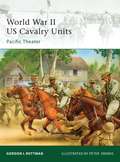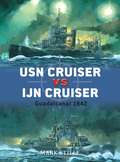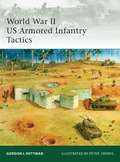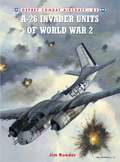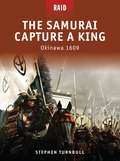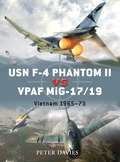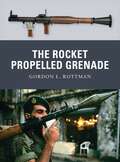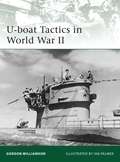- Table View
- List View
The Cabanatuan Prison Raid: The Philippines 1945 (Raid)
by Howard Gerrard Gordon L. Rottman Mariusz KozikOn 27 January 1945 the 6th Ranger Battalion and the 6th Army Special Reconnaissance Unit (the Alamo Scouts) began the most dangerous and important mission of their careers to rescue 500 American, British and Dutch prisoners-of-war held at a camp near Cabanatuan. This daring plan was fraught with difficulties – the rangers had to struggle with harsh jungle terrain, 30 miles behind enemy lines against a far larger force, knowing that if their secret mission was leaked, the POWs would be massacred by their captors. Yet, with the help of a Filipino guerilla force, they managed to liberate 513 prisoners and kill 225 Japanese in 15 minutes, while only suffering two losses themselves. Relive the dramatic rescue in this action-packed account, complete with bird's eye view and battlescene artwork. Gordon Rottman details the build-up to and execution of the operation, analyzing the difficulties faced and the contribution made by the guerrillas. This is a story not only of extraordinary military success but a compelling tale of courage in the face of overwhelming odds.
Merrill’s Marauders (Warrior #141)
by Adam Hook Edward M. YoungMerrill's Marauders were the first American Army infantry unit to fight in the China-Burma-India theatre, and one of the most renowned units to come out of World War II. The Marauders established a lasting reputation for hard fighting and tenacity in the face of adversity, combating a determined enemy, some of the most difficult and disease-ridden terrain in the world, and a seemingly indifferent higher command. Pushed beyond the limit of their endurance, at the end of nearly six months of operations behind Japanese lines, the remaining Marauders were withdrawn from combat after suffering over 90% casualties. Because of its courageous actions, the unit received the very rare honour of having every member presented with a Bronze Star for gallantry. This book explores the creation, training and combat experiences of the Marauders, one of the most famous units in the US Army's roll of honour.
Blue Division Soldier 1941–45: Spanish Volunteer on the Eastern Front (Warrior #142)
by Ramiro Bujeiro Carlos Caballero JuradoThe all-volunteer 'Blue Division' was a formation that allowed Franco's technically neutral Spain to support Nazi Germany's invasion of Russia. Following initial training in Germany, the Blue Division's units were sent to the Eastern Front in August 1941, where, after a 40-day march to the front, the Division fought in several major actions including Leningrad. In 1943, with the tide turning against the Axis forces in Russia, the Division was ordered to be withdrawn, yet many men chose to stay on and serve with the Volunteer Legion. Even after the collapse in the East, some volunteered to serve with Waffen-SS units through to the fall of Berlin in 1945. This book narrates the experiences of the common soldier, exploring his motivation for serving the Wehrmacht, and detailing his dramatic experiences in a brutal and hostile theatre of World War II.
World War II US Cavalry Units: Pacific Theater (Elite #175)
by Peter Dennis Gordon L. RottmanAt the time of Pearl Harbor, the United States Army still had ten cavalry regiments.The 26th (Filipino Scouts) fought on horseback in the Philippines, while the rest were fought as infantry. Despite this, the cavalry units maintained their own unique traditions, and identity as they saw action in the Pacific and China-Burma-India theatre. This book covers all of the US cavalry units to see action during World War II. It includes the little-covered Texan National Guard regiments, who fought beside ex-Merrill's Marauders as a deep penetration unit. It also contains color-plates of the uniforms of the US Army's last mounted cavalry as well as tropical combat dress worn by the dismounted units.
USN Cruiser vs IJN Cruiser: Guadalcanal 1942 (Duel)
by Howard Gerrard Paul Wright Mark StilleAlthough the war in the Pacific is usually considered a carrier war, it was the cruisers that dominated the early fighting. This thrilling duel presents the cruiser clashes during the battles for Guadacanal , highlighting the Battle of Savo Island and the Battle of Cape Esperance. The first was a Japanese victory that resulted in the loss of four Allied cruisers. However, in the latter, the Americans managed to turn the tables despite the battle being fought throughout the night. This book presents a view of the design and development of the opposing weapons systems, illustrated with newly commissioned digital artwork. It uses firsthand accounts to bring the battles to life and explain why the Americans suffered early on, but eventually had their revenge.
British Destroyers 1892–1918 (New Vanguard)
by Paul Wright Jim CrossleyThis book recounts the history of the first destroyers of the Royal Navy, which revolutionized the way war was fought at sea with new armaments and a great improvement on earlier designs. Moreover, between 1892, when the first destroyers were laid down, and 1918, destroyers evolved radically from 27-knot, 250-ton ships into 35-knot, 1,530-ton ships. All these ships were involved in some form during World War I; the smaller, original destroyers in an auxiliary support role and the newer, larger destroyers at some of the greatest sea battles of the war. This account highlights the role the destroyers played in the North Sea during the crucial battles to control the Heliogoland Bight, as well as the major fleet action at the battle of Jutland in 1916. Complete with a detailed description of the technical evolution of each class of destroyer from the 27-knotters to the Tribal and Marksman classes, Jim Crossley offers a complete overview of the vessels that helped to maintain Britain's naval supremacy.
World War II US Armored Infantry Tactics (Elite #176)
by Peter Dennis Gordon L. RottmanLittle has been published on US armored infantry units and tactics over the years. However, their contribution to the war effort was hugely important. There were a total of 57 armored infantry battalions and two regiments that served throughout the war and in all theaters. Equipped with halftracks, they fought as part of combined arms teams and combat commands alongside tanks, tank destroyers and artillery battalions. Significantly, they were not simply standard infantry battalions provided with halftracks. Their company and platoon organization was very different from the standard infantry unit and these highly mobile, heavily armed battalions fought in an entirely different manner. Using period training manuals and combat reports this book provides an exclusive look at the unique tactics developed by US armored infantry units including movement formations and battle drills.
The Atlantic Wall: Belgium, The Netherlands, Denmark and Norway (Fortress #89)
by Steven J. Zaloga Adam HookGermany's Atlantic Wall was the most ambitious military fortification program of World War II. Following its conquest of Western Europe, Germany had to defend some 5,000km of Atlantic coastline from the Spanish border to the Arctic Circle. The United States' entry into the war and the inevitability of an Anglo-American landing in Western Europe resulted in the fortification of this coastline along its entire length. Focusing on the northern Atlantic Wall in the Low Countries and Scandinavia, this title addresses the special defensive features and unique aspects of fortification in these countries, such as the early focus on fortifying Norway, due to early British commando raids; the greater use of turreted naval guns; and the establishment of first-line Flak defences in the Low Countries to counter the Allied strategic bombing campaign.
Greek Fortifications of Asia Minor 500–130 BC: From the Persian Wars to the Roman Conquest (Fortress)
by Konstantin Nossov Brian DelfSandwiched between the heart of ancient Greece and the lands of Persia, the Greek cities of Western Anatolia were the spark that ignited some of the most iconic conflicts of the ancient world. Fought over repeatedly in the 5th century BC, their conquest by the Persians provided a casus belli for Alexander the Great to cross the Hellespont in 334 BC and launch the battle of Granicus and the sieges of Miletus and Halicarnassus. A blend of Greek and Asian styles of military architecture, these fortified cities were revolutionary in their multi-linear construction – successive defensive walls – with loopholes and mural arches. Konstantin Nossov illustrates the evolution of Greek fortifications and the influences of the region they bordered in this fascinating study.
Israeli A-4 Skyhawk Units in Combat (Combat Aircraft #81)
by Jim Laurier Shlomo AloniThe light and agile A-4 Skyhawk was the first modern American jet to be offered to the Israeli Air Force, marking the point where the US took over from France as Israel's chief military supplier. Deliveries began too late for the A-4 to fight in the Six-Day War, but it soon formed the backbone of the IAF's ground-attack force. From 1969 to 1970 it flew endless sorties against Egyptian forces in the War of Attrition. Then, during the Yom Kippur War, five squadrons of A-4s saw combat and 50 planes were lost as they battled against the Arab armored onslaught. Using previously unpublished first-hand accounts and rare photography from the IAF archives and pilots' private collections, Shlomo Aloni tells the definitive history of the IAF's A-4 squadrons, including the story of Ezra "BABAN†? Dotan who became an ace with an unique double-kill of MiG17s.
A-26 Invader Units of World War 2 (Combat Aircraft)
by Janusz Swiatlon Jim RoederDesigned to combine the bombing capability of the B-26 Marauder with the versatility of the ground-attack A-20 Havoc, the A-26 Invader would become the USAAF's attack bomber par excellence. Capable of flying low-level strafing or conventional bombing missions by simply changing the nose configuration of the aircraft, the Invader first saw action in 1943 in the Pacific Theatre attacking Japanese-held islands. Arriving in Europe several months later, the A-26 served with distinction for the remainder of World War 2. In fact, the design proved so successful that it would go on to fly combat missions for a further two decades. Written by military aviation expert, Jerry Scutts, and illustrated with brand-new colour profiles and rare photography, this is the first book to focus exclusively on the A-26's missions in World War 2.
The Samurai Capture a King: Okinawa 1609 (Raid)
by Stephen Turnbull Richard Hook Donato SpedaliereA brilliant but little-known operation, the Shimazu clan raid on the independent kingdom of Ryukyu (modern Okinawa) in 1609 is one of the most extraordinary episodes in samurai history and the culmination of centuries of rivalry between the two powers. The defeat of the Shimazu at Sekigahara in 1600, and their need to win favour with the new Shogun, led them to hatch an audacious plot to attack the islands on the Shogun's behalf and bring back the king of Ryukyu as a hostage. Stephen Turnbull gives a blow-by-blow account of the operation, from the daring Shimazu amphibious landing, to their rapid advance overland, and the tactical feigned retreat that saw the Shimazu defeat the Okinawan army and kidnap their king in spectacular fashion. With a detailed background and specially commissioned artwork, the scene is set for a dramatic retelling of this fascinating raid.
Ships of the American Revolutionary Navy (New Vanguard)
by Tony Bryan Mark LardasMark Lardas explores the origins of American warships, primarily light and medium frigates, built for the Continental Navy during the years 1776–1783. This was the first navy of the United States and much of the fleet was comprised of ships that had been modified from existing vessels, converted into warships to provide a crucial service during the American Revolutionary War. Despite having no real funding, this unique fleet had a surprising amount of success against the might of the Royal Navy, and this title discusses the strengths and weaknesses of each design, and the differences between European and American warships of the time. With a close look at how these ships performed in key battles, as well as the exploits of John Paul Jones – the founding father of the United States Navy – this is a complete, illustrated overview of the ships' service and development until France's entry into the war and the subsequent decline in importance of the Continental Navy.
USN F-4 Phantom II vs VPAF MiG-17/19: Vietnam 1965–73 (Duel)
by Jim Laurier Gareth Hector Peter E. DaviesThe Vietnam War placed unexpected demands upon American military forces and equipment.The principal US naval fighter, the McDonnell F-4 Phantom, had originally been designed to defend the Fleet from air attack at long range. However, its tremendous power and bomb-carrying capacity made it an obvious candidate for the attack mission in Vietnam from 1965 onwards. Its opponent was the MiG-17, a direct descendant of the MiG-15, which had given USAF Sabre jets a hard fight in the Korean War. This book brings to life their dangerous duels and includes detailed cockpit views and other specially commissioned artwork to highlight the benefits and shortcomings of each plane type. It was in the skies over Vietnam that many of the techniques of air combat evolved as pilots learned how to use and to defeat supersonic fighters for the first time.
German Special Forces of World War II (Elite)
by Mike Chappell Gordon WilliamsonA fascinating and long overdue study of the troops that made up Germany's elite special forces of World War II. Such forces included the legenday Skorzeny Commandos who carried out audacious tasks such as the glider-borne rescue of Mussolini, and the kidnapping of the son of the Hungarian regent, Admiral Horthy. This book also includes details of lesser-known units such as the Brandenburgers, who operated behind enemy lines in captured uniforms, and the Kleinkampfverbände who were the forerunners of modern-day naval combat troops like the US Navy SEALs. Complete with uniform and kit detail together with action accounts of many of these daring operations, this book is a must-have for any special forces enthusiast.
The Thompson Submachine Gun: From Prohibition Chicago to World War II (Weapon)
by Peter Dennis Martin PeglerThe Thompson submachine gun, or Tommy gun developed an almost iconic status during the 20th century. It had an unusual beginning, for it was developed during the dying days of World War I as a 'one-man, hand-held machine gun.' The war ended before these first prototypes could be shipped to Europe but once the M1921 Thompson formally entered production it was used by the criminals working in Chicago and New York during the 1920s. With the police increasingly outgunned they too were forced to equip themselves with the Tommy gun. It quickly came to be used in Hollywood films, and by the end of the 1930s it would have probably faded from view had history not intervened. With the entry of the US into World War II there was an urgent need to equip and arm a force of epic proportions; the Thompson submachine gun began a second career as part of the US Army. It also became the weapon of choice for the small band of British commandos as they conducted a number of daring raids against the heart of occupied Europe.
Katana: The Samurai Sword (Weapon)
by Stephen Turnbull Johnny ShumateThe Samurai sword of Japan is probably the finest edged weapon ever made. This volume by leading Samurai expert Stephen Turnbull reveals the story of how and why it achieved this distinction. Particular attention is paid to the development of the familiar curved blade from the original straight blades, the associated development of Japan's famous steel-making techniques and the challenges from contemporary warfare. Together with the technical details of forging, polishing, mounting and testing; this volume is brought to life with details of the great swordmakers themselves. Moreover, no history of the sword would be complete without a detailed examination of its use in combat, from the greatest Samurai armies to individual duels and revenge killings. Personal accounts allow the reader to discover the art of Japanese swordsmanship in the hands of masters such as Miyamoto Musashi to the unnamed Japanese warrior defending his family's honour. This lively text is perfectly complemented by artwork reconstructions of the sword in use and colour photographs of the swords in use.
The Rocket Propelled Grenade (Weapon #2)
by Tony Bryan Ramiro Bujeiro Gordon L. RottmanThe RPG-series of weapons is the most widely used family of lightweight antitank weapons in the world today. RPGs have been used not only against their intended targets, but against personnel, fortifications, buildings, soft-skin vehicles, watercraft, and aircraft. Lightweight, relatively compact, easy to operate and maintain, they meet most of the requirements of any armed group. Like any weapon system, RPGs and their ammunition have their limitations. While these limitations are much touted by proponents of more advanced weapons, they lose sight of many armed groups' requirement for lightweight, compact, inexpensive, easy to operate and maintain weapons. Most sophisticated weapons tend to be just the opposite – heavy, cumbersome, excessively expensive, and requiring extensive training and an advanced support infrastructure. They are also more difficult to obtain due to export controls and restrictions. To be effective, an army actually needs a mix of both sophisticated and uncomplicated weapons. Gordon Rottman provides a detailed analysis of perhaps one of the most important weapons to be developed in the 20th century.
Medieval Handgonnes: The first black powder infantry weapons (Weapon)
by Gerry Embleton Sean McLachlan Sam EmbletonIn the early 14th century, a new weapon entered the arsenals of European armies. This first generation of black powder weapons put fear into the heart of the enemy and in 1453 Ottoman cannon succeeded in pummelling the once-impregnable walls of Constantinople. But cannons, which are both slow and cumbersome, were difficult to use and often proved inaccurate. The first handgonnes were the answer. Easily dismissed by later historians as nothing more than crude tubes that shot wildly inaccurate lead balls, more recent research has revealed the true accuracy of the medieval handgonne together with its penetrative power. This volume, complete with detailed illustrations and colour photographs of reconstructed handgonnes, reveals the true history of what could easily have been the most revolutionary weapon in history.This book will be a must for medieval enthusiasts and re-enactors.
British Dreadnought vs German Dreadnought: Jutland 1916 (Duel)
by Howard Gerrard Ian Palmer Mark StilleIn 1916, in the seas near Jutland, two fleets of armoured dreadnoughts met in open battle. This book tells the story of the British and German battleships of these two great fleets – from their development as the first generation of fullyarmoured warships – to their combat experiences. The differing weapon systems and crew training of the British and German fleets are examined in detail, as is the titanic struggle of Jutland, through an hour-by-hour, shot-by-shot, reconstruction. Finally, it analyzes the outcome of the struggle, explaining the successes and failures of these great battleships.
Carl Rückert's Memoirs of the Franco-Prussian War
by Alfred KellyThis book offers the first English-language translation of the finest soldier’s memoir to emerge from the Franco-Prussian War, titled With my Rucksack: The Unvarnished Campaign Memoirs of an Infantryman from the Year 1870 by Carl Rückert. Lasting from 1870–1871, this was the war that made the modern German nation and set Europe on the path to World War I, and Carl Rückert offers an unrivalled worm’s eye view of the experiences of common soldiers who fought in it. A Hessian lance corporal in the German army, he was a close observer of daily hardships, class tensions, the influence of nationalism, and the terrors of combat. He was gravely wounded in the war’s decisive battle at Gravelotte, where he was among the first Europeans to face the horrors of breech-loading rifles, machine guns, and accurate artillery. Accompanied by an insightful translator’s introduction and a wealth of footnotes, this book is an invaluable link to the everyday realities of the Franco-Prussian War.
Carl Rückert's Memoirs of the Franco-Prussian War
by Alfred KellyThis book offers the first English-language translation of the finest soldier’s memoir to emerge from the Franco-Prussian War, titled With my Rucksack: The Unvarnished Campaign Memoirs of an Infantryman from the Year 1870 by Carl Rückert. Lasting from 1870–1871, this was the war that made the modern German nation and set Europe on the path to World War I, and Carl Rückert offers an unrivalled worm’s eye view of the experiences of common soldiers who fought in it. A Hessian lance corporal in the German army, he was a close observer of daily hardships, class tensions, the influence of nationalism, and the terrors of combat. He was gravely wounded in the war’s decisive battle at Gravelotte, where he was among the first Europeans to face the horrors of breech-loading rifles, machine guns, and accurate artillery. Accompanied by an insightful translator’s introduction and a wealth of footnotes, this book is an invaluable link to the everyday realities of the Franco-Prussian War.
Imperial Japanese Navy Heavy Cruisers 1941–45: Imperial Japanese Navy Heavy Cruisers 1941-1945 (New Vanguard)
by Paul Wright Mark StilleDesigned with little more than a passing nod to the international naval treaties of the inter-war period, the Imperial Japanese Navy's heavy cruisers were fast and heavily armed. Like the other vessels of the Japanese Navy, the heavy cruisers were technologically superior to and far more innovative than their Allied rivals, whom they met in many of the major Pacific Theatre battles, including Midway and Leyte Gulf. Mark Stille continues his study of the IJN of WWII with this fascinating topic, addressing the design and development of all 18 ships in the six heavy cruiser classes, from pre-war construction and mid-war alterations, to their operational histories and eventual fates.
U-boat Tactics in World War II (Elite)
by Ian Palmer Gordon WilliamsonAt the start of the war, German U-boat technology vastly out performed that possessed by the Allies, and under the pressure of the war continual development helped keep pace with wartime needs and improvements in anti-submarine weaponry. But it was not just the technology that had to change. German U-boat tactics evolved over time. Used in a variety of roles, from coastal patrolling through to the combined actions of convey-hunting 'wolf packs', the tactics used by U-Boats were diverse. This book analyses how the U-boats dominated the seas thanks to their innovative and daring tactical deployment, and how the cracking of the Enigma code effectively hamstrung them, greatly reducing their impact, a problem that even their advanced tactics failed to solve.
World War II Allied Sabotage Devices and Booby Traps (Elite #184)
by Peter Dennis Gordon L. RottmanFollowing Churchill's directive to 'set occupied Europe ablaze,' the SOE and later its American sister organization, the OSS, were deployed across the continent. Outnumbered, surrounded and in great peril, these brave agents were armed with a wide variety of devices to help them achieve their objectives, including numerous pieces of sabotage equipment and cunning booby traps. This book examines these different pieces of equipment and the technicalities involved in deploying them effectively, as well as discussing the specialist equipment developed by Special Forces units, including the SAS Lewes Bomb. Touching on some of the stranger developments, such as explosives disguised as lumps of coal, the author goes on to describe the German clearance techniques that were developed to avoid these dangers. Complete with specially commissioned artwork and period diagrams together with detailed descriptions of the dangerous missions of Allied agents, this book is a fascinating insight into the secret war behind enemy lines.



